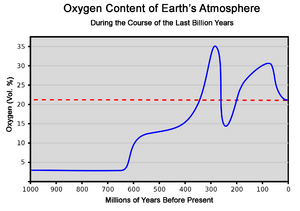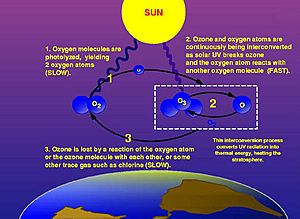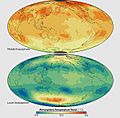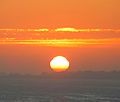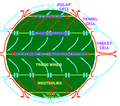Air facts for kids
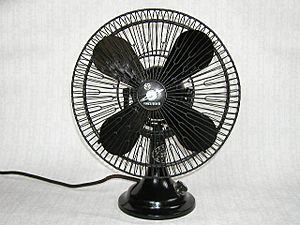
Air refers to the Earth's atmosphere. Air is a mixture of many gases and dust particles. It is the clear gas in which living things live and breathe. It has an indefinite shape and volume. It has mass and weight because it is matter. The weight of air creates atmospheric pressure. There is no air in outer space.
Air is a mixture of about 78% nitrogen, 21% oxygen, 0.9% argon, 0.04% carbon dioxide, and very small amounts of other gases. There is an average of about 1% water vapor in the air.
Humans and animals need to breathe oxygen in the air. In breathing, the lungs put oxygen into the blood and send back carbon dioxide to the air. Plants need the carbon dioxide in the air to live. They give off the oxygen that we breathe. Without it, we die of asphyxia. Plants and humans have a symbiotic relationship.
Wind is moving air. This causes weather.
Air can be polluted by some gases (such as carbon monoxide, hydrocarbons, and nitrogen oxides), smoke, and ash. This air pollution causes various problems including smog, acid rain, and global warming. It can damage people's health and the environment.
Since early times, air has been used to create technology. Ships moved with sails and windmills used the mechanical motion of air. Aircraft use propellers to move air over a wing, which allows them to fly. Pneumatics use air pressure to move things. Since the late 1900s, air power is also used to generate electricity.
Air is invisible: it cannot be seen by the eye, though a shimmering in hot air can be seen.
Air is one of the four classical elements in the ancient Greek concept of four basic elements (earth, water, air, and fire). It was considered the driving force for the birth of the cosmos.
Contents
The evolution of the Earth's atmosphere
The history of the Earth's atmosphere before one billion years ago is poorly understood. Scientists are still researching it and making guesses based on what they find.
The modern atmosphere is sometimes referred to as Earth's "third atmosphere," to tell the difference between the current chemical composition and the two different previous compositions. Some scientists believe that the original atmosphere was mostly helium and hydrogen.
Some scientists speculate that about 3.5 billion years ago, the surface had cooled enough to form a crust, still heavily populated with volcanoes which released steam, carbon dioxide, and ammonia. This led to the "second atmosphere," which was primarily carbon dioxide and water vapor, with some nitrogen but virtually no oxygen. This second atmosphere had approximately 100 times as much gas as the current atmosphere. It is generally believed that the greenhouse effect, caused by high levels of carbon dioxide, kept the Earth from freezing.
During the next few billion years, water vapor condensed to form rain and oceans, which began to dissolve carbon dioxide. Approximately 50% of the carbon dioxide would be absorbed into the oceans. One of the earliest types of bacteria was the cyanobacteria.
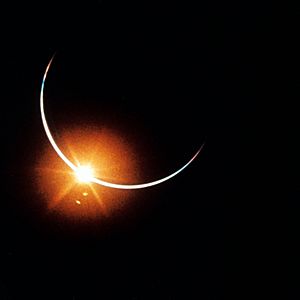
Fossil evidence indicates that these bacteria existed approximately 3.3 billion years ago and were the first oxygen-producing evolving organisms. They were responsible for the initial conversion of the earth's atmosphere from a state without oxygen to a state with oxygen. Being the first to carry out oxygenic photosynthesis, they were able to convert carbon dioxide into oxygen, playing a major role in oxygenating the atmosphere.
Photosynthesizing plants would later evolve and convert more carbon dioxide into oxygen. Over time, excess carbon became locked in fossil fuels, sedimentary rocks (notably limestone), and animal shells.
As oxygen was released, it reacted with ammonia to create nitrogen; in addition, bacteria would also convert ammonia into nitrogen.
As more plants appeared, the levels of oxygen increased, while carbon dioxide levels dropped. At first, the oxygen combined with various elements (such as iron), but eventually oxygen accumulated in the atmosphere, resulting in mass extinctions and further evolution.
With the appearance of an ozone layer (ozone is an allotrope of oxygen), life forms were better protected from ultraviolet radiation. This oxygen-nitrogen atmosphere is the "third atmosphere."
Interesting facts about air
- The average person breathes about two gallons of air per minute.
- Air acts as an insulator in the atmosphere.
- Most of our air comes from plants but not from the plants we normally picture in our minds. It comes from ocean algae.
- Air can hold tiny water droplets. This is called humidity.
- When your ears pop when you drive up a hill, it is because there is less air pressure at higher elevations.
- Bioaerosols are tiny microbial organisms that can be carried by air.
- The fastest gust of wind recorded on earth was 253 miles per hour.
Related pages
Images for kids
-
Blue light is scattered more than other wavelengths by the gases in the atmosphere, surrounding Earth in a visibly blue layer when seen from space on board the ISS at an altitude of 335 km (208 mi).
-
Space Shuttle Endeavour orbiting in the thermosphere. Because of the angle of the photo, it appears to straddle the stratosphere and mesosphere that actually lie more than 250 km (160 mi) below. The orange layer is the troposphere, which gives way to the whitish stratosphere and then the blue mesosphere.
-
Temperature trends in two thick layers of the atmosphere as measured between January 1979 and December 2005 by microwave sounding units and advanced microwave sounding units on NOAA weather satellites. The instruments record microwaves emitted from oxygen molecules in the atmosphere. Source:
See also
 In Spanish: Atmósfera terrestre para niños
In Spanish: Atmósfera terrestre para niños



